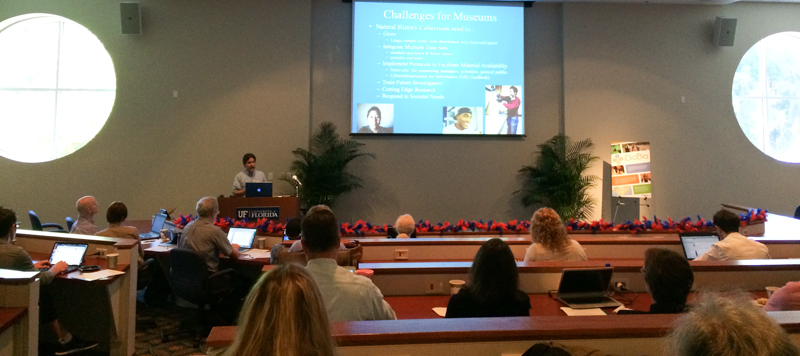“Those millions of bugs on pins, pressed plants, preserved animals and fossils hold a wealth of information about the adaptive abilities of our natural world, not to mention the DNA and curative uses yet to be discovered.”

More than 80 researchers and students from 48 institutions in seven countries met at the “Collections for the 21st Century” symposium held May 5-6 at the University of Florida, Gainesville, Florida, to facilitate new research, collaboration, and educational opportunities.

The symposium was hosted by iDigBio, in conjunction with the Natural Science Collections Alliance, whose effort to digitize an estimated 1 billion biological specimens housed in natural history museums and collections across the country, has already brought a tremendous amount of data on-line for new and exciting uses. At the symposium, scientists unveiled the latest technology in biological specimen digitization and took the initiative to demonstrate valuable ways the data can be used to meet the challenges facing biodiversity and human societies.
Presentations were given by international and nationally esteemed speakers representing the Smithsonian Institution, Cornell University, American Museum of Natural History, Brazil’s Centro de Referência em Informação Ambiental, The London Natural History Museum, Australia’s Scientific and Industrial Research Organization, and the National Science Foundation among others.

The symposium began with the broader brush strokes by Scott Miller of the Smithsonian Institution “Why We Have Natural History Collections”, and Greg Riccardi, iDigBio PI at Florida State University, depicting the impact of the Network Integrated Biocollections Alliance (NIBA), Advancing Digitiation of Biological Collections (ADBC), and iDigBio on the future of Biological Specimen collections.
The remainder of the morning and a portion of the afternoon were dedicated to cutting edge science that is impacting developments and advancements in digital biodiversity. These included a presentation by Pam Soltis (University of Florida), “Linking Molecular Data with Collections”, Jessica Maisano’s (University of Texas) work with high-resolution x-ray computed tomography data acquisition, and talks by Edwin Scholes, Cornell Lab of Ornithology, Dena Smith, University of Colorado, Jason Knouft, St. Louis University and Neil Cobb, Northern Arizona University.
Late afternoon speakers addressed international initiatives. Dora Canhos, Centro de Referência em Informação Ambiental, Brazil; Vincent Smith of the Natural History Museum, London; and Joanne  Daly, Commonwealth Scientific and Industrial Research Organization (CSIRO) Australia. (Please see links below to link to recordings of presentations and talks).
Daly, Commonwealth Scientific and Industrial Research Organization (CSIRO) Australia. (Please see links below to link to recordings of presentations and talks).
The day’s agenda was followed by an evening reception at the Florida Museum of Natural History.
Tuesday morning, participants listened to Scott Edwards of the U.S. National Science Foundation (NSF), “Opportunities and Challenges for Funding and Sustaining Natural History Collections.” His talk was followed by Bruce MacFadden of the Florida Museum of Natural History. He presented a report “Fossils in the Cloud: Advancing the Broader Impacts of iDigBio”. After a short morning break, Anna Monfils, Central Michigan University, Shari Ellis, Florida Museum of Natural History, Gil Nelson, Florida State University presented. Robert Guralnick, University of Colorado, closed the program. (Please see links below to link to recordings of presentations and talks).
The exchange of new technology, innovative ways to digitize and disseminate collections data, and opportunities for future collaboration and research, generated an excitement to the symposium that was inspiring.
 In the afternoon, the participants split up into three groups. One group hiked at Paynes Prairie, one group kayaked the Ichetucknee River and the other group visited the museum’s research and collections facility
In the afternoon, the participants split up into three groups. One group hiked at Paynes Prairie, one group kayaked the Ichetucknee River and the other group visited the museum’s research and collections facility
______________________________
PRESENTATION RECORDINGS
Day 1 5/5/2014
Day 2 5/6/2014





